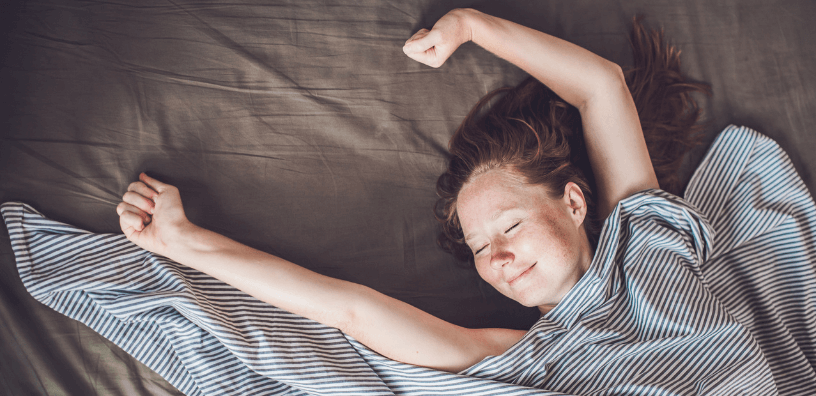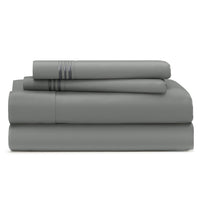
Sleep Soundly Even in the Heat—Here’s How to Stay Cool
As the weather warms up, so do your nights.
If you’re a hot sleeper—or noticed sleep getting trickier with age—you’re probably wondering how to stay cool at night without cranking the AC.
Luckily, you don’t have to suffer through another sweaty night. A few practical swaps and upgrades to your sleep environment can make a big difference!
Below, you’ll learn science-backed tips, including what fabrics to avoid, the best types of cooling bedding, and bonus hacks for a bedroom ready for a restful, refreshing sleep all spring and summer long!

Overheating & Sleep: How Age Plays a Role
As you age, sleeping patterns aren’t always consistent. Whether in your 30s, 50s, or beyond, you may notice shifts in how your body responds to warmth at night.
Here are some of the most common reasons for heat-related sleep disruptions, grouped by age:
-
Young Adults (20s-30s): Late-night scrolling, erratic sleep schedules, and daily stress can throw off your body’s internal thermostat, leading to restless, overheated nights.[1]
-
Middle Age (40s-50s): Hormones on a rollercoaster? Menopause, testosterone shifts, and other midlife changes can bring on night sweats and unexpected heat waves.[2,3]
-
Older Adults (60+): With age comes wisdom… and sometimes a few extra degrees of heat. Slower metabolism, circulation changes, and thinner skin can make temperature swings more noticeable.[1]

Stop Sleeping Hot: The Fabrics That Trap Heat
Do you know what kind of material you’re sleeping on? Getting into bed with the wrong fabrics can disrupt the body’s natural sleep cycle. When your body temperature is too hot, reaching the deeper stages of sleep becomes more difficult, resulting in endless restless nights.[4]
Heavy winter fabrics, synthetic materials, and non-breathable bedding are not designed to be cooling or temperature-regulating and tend to trap in the heat. So, check your tags, looking out for these common heat-retaining culprits:
-
Cotton
-
Down
-
Wool
-
Flannel
-
Velvet
-
Cashmere
How Bamboo Bedding Helps with Night Sweats & Irritation
Unlike cotton and synthetic fabrics, viscose from bamboo is extremely cooling, breathable, and naturally hypoallergenic, making it the best choice for sensitive skin and hot sleepers![5]
Pure bamboo viscose is unique—instead of absorbing sweat and moisture, it stays on the fabric’s surface and quickly evaporates into the air.[6] This is key to keeping your body temperature regulated and preventing dreaded night sweats.
Here are three more reasons why bamboo is the mindful bedding choice: [5,6]
-
Maximum Breathability, Better Sleep: With its naturally breathable weave, bamboo bedding keeps air flowing, so heat doesn’t get trapped under the covers.
-
Light as a Cloud, Soft as Silk: Silky-smooth and feather-light, bamboo bedding feels luxurious while staying cooler than cotton.
-
Gentle on Skin, Tough on Irritants: Naturally hypoallergenic, bamboo helps combat irritants for a cleaner and fresher sleep environment.

Best Bamboo Bedding Swaps for a Cooler Night’s Sleep
No more waking up drenched in sweat! Experience restful nights and improved sleep quality with innovative bamboo bedding alternatives that keep you cool and comfortable.
The soft and lightweight bedding recommendations below will have you daydreaming of the moment you can slip underneath the covers and enjoy a cool, crisp sleep:
Bed Sheets
Sheets are the foundation of your bed—these naturally soft and smooth 100% Bamboo Sheets are designed to promote airflow, wick away moisture, and regulate the body’s temperature to help reduce night sweats.
Pillowcases
The body naturally cools down by sweating through the scalp, face, and neck.[7] Using a pillowcase that traps heat and moisture prevents this. Instead, choose a breathable, lightweight pillowcase, like this 100% Bamboo Pillowcase.
Duvet Cover
Want to be comfortable and snuggled up without overheating? This 100% Bamboo Duvet Cover Set is crafted from the highest quality of pure bamboo viscose for a lightweight yet cozy sleep that doesn’t trap heat.

Quick Pro Tips for Staying Cool at Night
Alongside our recommendations for soft and lightweight bedding, here are some additional tips and tricks to help you banish stuffy and disrupted sleep for good:
-
Adjust room temperature: Keep the bedroom between 60-72°F for optimal sleep.[8]
-
Use a fan or open windows for better airflow.
-
Stick to lightweight sleepwear made from natural, breathable fabrics.
-
Stay hydrated and avoid heavy meals before bed.
-
Invest in a cooling mattress protector for extra comfort.
-
Layer Wisely: Instead of thick blankets, use a breathable throw for cool mornings and evenings.
The Role of Humidity in Sleep Comfort
If you incorporate breathable bedding, but feel like it isn’t helping, your bedroom might have high humidity levels, making it harder for sweat to evaporate as easily.
Check for condensation on windows, walls, or pipes, along with musty odors or mold growth—these are telltale signs of excess humidity. For an accurate reading, use a hygrometer to measure the moisture levels in the air.
If your space has high moisture levels, consider investing in a dehumidifier. The size of the dehumidifier you need will depend on the square footage of your bedroom:
-
-
Small Bedroom (Up to 300 sq. ft.): Compact Dehumidifier
-
Medium Bedroom (300-700 sq. ft.): Mid-Sized Dehumidifier
-
Large Bedroom (700+ sq. ft.) or High Humidity: High-Capacity Dehumidifier
-
Pro Tip: Adding a houseplant or two can help, too. Snake plants, peace lilies, or Boston ferns absorb moisture and naturally help regulate humidity.[9]
Upgrade Your Sleep for Summer!
No matter your age, tossing and turning in the heat doesn’t have to be your reality. With the right cooling bedding, breathable fabrics, and a few smart adjustments to your sleep environment, you can enjoy restful nights even as temperatures rise. Whether it’s swapping out heat-trapping materials, managing humidity levels, or choosing moisture-wicking bamboo bedding, these simple changes can make a world of difference.
Don’t let another sweaty night steal your sleep—shop Cosy House Collection and embrace cooling comfort!
To shop our collection & get 10% OFF, use the code 'BLOG10' at checkout.
-
Resources:
-
Dijk, D. J., Duffy, J. F., Riel, E., Shanahan, T. L., & Czeisler, C. A. (1999). Ageing and the circadian and homeostatic regulation of human sleep during forced desynchrony of rest, melatonin and temperature rhythms. The Journal of physiology, 516 ( Pt 2)(Pt 2), 611–627. https://doi.org/10.1111/j.1469-7793.1999.0611v.x
-
Baker, F. C., Lampio, L., Saaresranta, T., & Polo-Kantola, P. (2018). Sleep and Sleep Disorders in the Menopausal Transition. Sleep medicine clinics, 13(3), 443–456. https://doi.org/10.1016/j.jsmc.2018.04.011
-
Deecher, D., Dorries, K. Understanding the pathophysiology of vasomotor symptoms (hot flushes and night sweats) that occur in perimenopause, menopause, and postmenopause life stages. Arch Womens Ment Health 10, 247–257 (2007). https://doi.org/10.1007/s00737-007-0209-5
-
Harding, E. C., Franks, N. P., & Wisden, W. (2020). Sleep and thermoregulation. Current opinion in physiology, 15, 7–13. https://doi.org/10.1016/j.cophys.2019.11.008
-
Yang, M. xing, Zhang, Y., Liu, H. W., & Zheng, Q. T. (2011). Factors affecting thermal and moisture comfort of bamboo fabric. Advanced Materials Research, 332–334, 808–811. https://doi.org/10.4028/www.scientific.net/amr.332-334.808
-
Amjad, A. I. (2024). Bamboo fibre: A sustainable solution for textile manufacturing. Advances in Bamboo Science, 7, 100088. https://doi.org/10.1016/j.bamboo.2024.100088
-
Cao, Y., Lei, T. H., Wang, F., Yang, B., & Mündel, T. (2022). Head, Face and Neck Cooling as Per-cooling (Cooling During Exercise) Modalities to Improve Exercise Performance in the Heat: A Narrative Review and Practical Applications. Sports medicine - open, 8(1), 16. https://doi.org/10.1186/s40798-022-00411-4
-
Harding, E. C., Franks, N. P., & Wisden, W. (2019). The Temperature Dependence of Sleep. Frontiers in neuroscience, 13, 336. https://doi.org/10.3389/fnins.2019.00336
-
Jiang, J., Irga, P., Coe, R., & Gibbons, P. (2024). Effects of indoor plants on CO2 concentration, indoor air temperature and relative humidity in office buildings. PloS one, 19(7), e0305956. https://doi.org/10.1371/journal.pone.0305956


